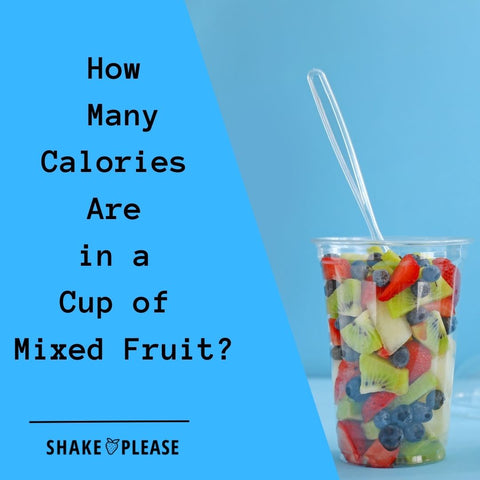
Calorie counting can be a crucial aspect of maintaining a healthy diet, especially when it comes to consuming fruits.
As a health-conscious individual, you may be curious about the calorie content of a cup of mixed fruit.
In this comprehensive article, we'll dive deep into the world of mixed fruit calories, explore the nutritional benefits, and provide you with valuable tips for incorporating this delightful treat into your balanced lifestyle.
Calorie Counting 101
Before we delve into the specifics of mixed fruit calories, it's essential to understand the basics of calorie counting. Calories are a unit of measurement that represents the energy content in food.
When you consume more calories than your body needs, the excess energy is stored as fat, potentially leading to weight gain. Conversely, consuming fewer calories than your body requires can result in weight loss.
Understanding the calorie content of the foods you consume is the first step towards achieving your health and fitness goals.
How to Measure Calories in a Cup of Mixed Fruit
Measuring the calorie content of a cup of mixed fruit can be a straightforward process. The calorie count can vary depending on the specific fruits included in the mix, as well as the portion size.
To determine the calorie content, you can refer to nutritional information provided on the packaging or consult reliable online resources.
Alternatively, you can use a food tracking app or database to look up the calorie values of individual fruits and calculate the total calorie count for your mixed fruit serving.
Calorie Content of Popular Fruits in a Cup of Mixed Fruit
The calorie content of a cup of mixed fruit can vary depending on the combination of fruits used. Here's a breakdown of the calorie content of some popular fruits in a one-cup serving:
| Fruit | Calories per Cup |
|---|---|
| Apples | 57 calories |
| Bananas | 105 calories |
| Blueberries | 84 calories |
| Grapes | 100 calories |
| Oranges | 85 calories |
| Pineapple | 82 calories |
| Strawberries | 49 calories |
By understanding the calorie content of individual fruits, you can estimate the overall calorie count of your mixed fruit serving and make informed choices about your dietary intake.
Nutritional Benefits of Mixed Fruit
In addition to being a delicious treat, mixed fruit offers a wealth of nutritional benefits.
Fruits are packed with essential vitamins, minerals, and antioxidants that support various aspects of your health. Consuming a variety of fruits in the form of a mixed fruit cup can provide you with a diverse array of these beneficial nutrients, including:
- Vitamin C: Supports immune function, collagen production, and skin health.
- Potassium: Helps maintain healthy blood pressure and supports heart health.
- Fiber: Promotes digestive health, satiety, and regular bowel movements.
- Antioxidants: Protect cells from damage and reduce the risk of chronic diseases.
Incorporating mixed fruit into your diet can be an excellent way to meet your daily fruit intake recommendations and contribute to your overall well-being.
What is Mixed Fruit?
Mixed fruit, also known as fruit salad, is a combination of various fresh or canned fruits.
The specific fruits included in a mixed fruit cup can vary, but common choices may include apples, bananas, grapes, strawberries, pineapple, and more.
The combination of different fruits not only adds visual appeal but also provides a diverse array of flavors and textures for your taste buds to enjoy.
The Importance of Understanding Calorie Intake
Knowing the calorie content of the foods you consume is crucial for maintaining a healthy and balanced diet.
Tracking your calorie intake can help you achieve your weight management goals, whether you're aiming to lose, gain, or maintain your current weight.
By understanding the calorie count of a cup of mixed fruit, you can make informed decisions about portion sizes and incorporate this nutritious treat into your overall dietary plan.
Factors that Can Affect Calorie Count in Mixed Fruit
Several factors can influence the calorie count of a cup of mixed fruit, including:
- Fruit Composition: The specific fruits included in the mix and their individual calorie contents can impact the overall calorie count.
- Portion Size: The amount of mixed fruit you consume can significantly affect the total calorie intake.
- Preparation Method: If the mixed fruit is served with additional ingredients, such as sweeteners or syrups, the calorie count may increase.
- Freshness: The calorie content of fresh fruits may differ from canned or frozen varieties due to differences in water content and processing methods.
Understanding these factors can help you make more informed choices when selecting and consuming mixed fruit.
Types of Berries and Their Health Benefits
Tips for Incorporating Mixed Fruit into a Healthy Diet
Incorporating mixed fruit into a healthy diet can be a delightful and nutritious addition. Here are some tips to help you make the most of this versatile treat:
- Opt for Whole, Fresh Fruits: Whenever possible, choose a mix of fresh, whole fruits over canned or processed options, as they tend to be lower in added sugars and preservatives.
- Pair with Protein: Combine your mixed fruit with a source of protein, such as Greek yogurt or cottage cheese, to create a balanced and satisfying snack or meal.
- Use as a Topping: Sprinkle mixed fruit on top of oatmeal, cereal, or salads to add natural sweetness and a nutritional boost.
- Blend into Smoothies: Incorporate mixed fruit into your favorite smoothie recipes for a nutrient-dense and refreshing beverage.
- Enjoy as a Dessert: When you're craving something sweet, opt for a serving of mixed fruit instead of a more calorie-dense dessert option.
By following these tips, you can enjoy the delicious flavors and health benefits of mixed fruit while maintaining a balanced and nutritious diet.
Other Considerations When Calculating Calorie Intake
When calculating the calorie intake from a cup of mixed fruit, it's important to consider the following factors:
- Serving Size: Ensure you are accurately measuring a one-cup serving, as the calorie count can vary significantly depending on the portion size.
- Dietary Restrictions: If you have specific dietary needs or preferences, such as being vegan or following a low-carb diet, the calorie content and macronutrient breakdown of the mixed fruit may be particularly relevant.
- Individual Metabolism: Your personal metabolic rate and activity level can influence how your body processes and utilizes the calories from the mixed fruit.
By taking these considerations into account, you can better understand how the calories in a cup of mixed fruit fit into your overall dietary goals and lifestyle.
Raspberry vs Blueberry - Which One Reigns Supreme?
Conclusion
Navigating the calorie content of a cup of mixed fruit can be a valuable tool in maintaining a balanced and healthy diet.
By understanding the calorie breakdown of individual fruits, the nutritional benefits of mixed fruit, and the factors that can influence the calorie count, you can make informed choices about incorporating this delightful treat into your lifestyle.





